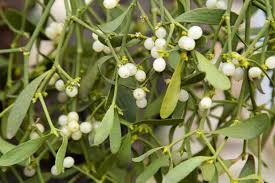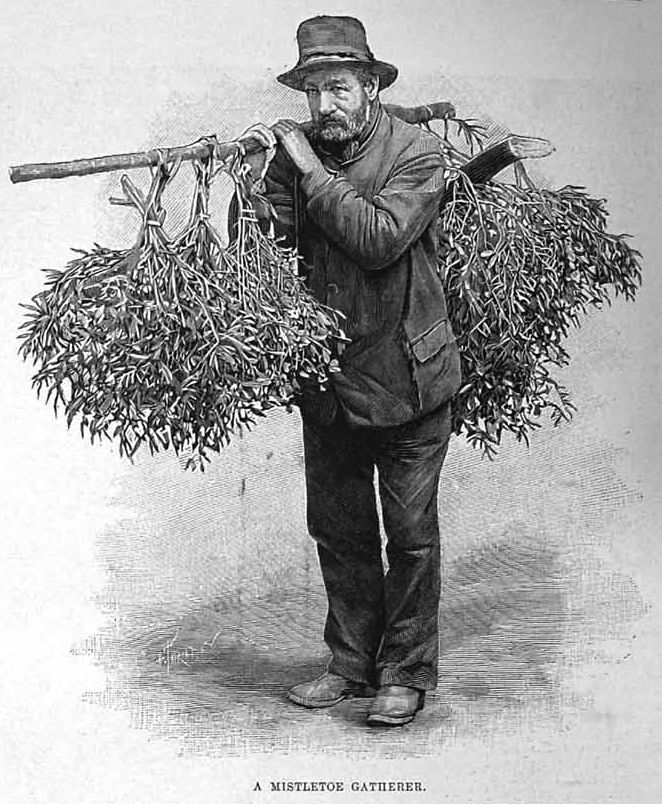|
January 17th has come and gone, and to some is known as Old Twelfth Night. In 1752 the calendar was changed, and Twelfth Night is now January 6th, also known as the Feast of Epiphany, but to those who follow the old calendar, it would be this eve that Wassailing orchards and other festivities would be observed. We’ve talked about the magic of wassailing here, but tonight I want to pay homage to a strange and special plant that never touches the Earth. Though Christmas has passed us, Mistletoe, Viscum album, has long been a powerful magical plant of the Yuletide season and the Winter months. It’s name comes from the Old English misteltãn. This parasitic plant that grows on various trees, particularly the apple tree, it is held in great veneration when found on Oak trees, which is often rare. Perhaps it is the rarity of it that has caused it to be held in such high regard by so many cultures. As a parasite that growths in neither sky nor earth, it has long held a reputation as a magical plant. A powerfully protective plant, both heralded as a protection against and of witches and magical practitioners, I find it to be indispensable from the Magical Herbaria of Winter. Since we’ve passed Twelfth night or January 5th- 6th, now it is time to deal with the remnants of the Winter Solstice celebrations and decor. In some traditions, it was on this night that the mistletoe would be burned, in others it was wrapped and secreted away to come out again for the following year. The most notorious folklore I’m sure almost everyone has heard, is that it’s best to kiss beneath the mistletoe. Peter Haining in his book 'Superstitions', "The mistletoe, was revered by the ancient Greeks as sacred, yet superstition has it that the reason why it is so lucky to be kissed under it is that the plant once offended the old Gods, who thereafter condemned it to have to look on while pretty girls were being kissed!" The origins of the associations with kissing and mistletoe are murky, though the role mistletoe played in the story of Baldur from norse legends may have something to do with it. It is said he was beloved above all other gods, and his mother Frigga, loved him best of all. Fitting, for she is the goddess of love and beauty amongst other things. She feared for the harm that life could bring Baldur, so she went about the land securing promises from all beings that they would not harm her son. But of course, there was one that was forgotten, mistletoe. Loki, the ever wicked trickster and ne’re do well of the ancients, made an arrow of the wood of the plant and convinced a blind god, Holder, brother of Baldur, to shoot it at him. Loki directed the arrow at Baldur’s heart and it struck him and killed him. There are multiple endings to the story and the strange translucent, white berries of the mistletoe can be seen as Frigga’s tears. If the story ends happy, Baldur is restored back to life and the love Frigga has long been associated with meant all who stood beneath this powerful plants would be bestowed with a kiss. In Holstein Germany, the branch is called “the branch of spectres” and is thought to cure fresh wounds and give luck in hunting. It also keeps away both thieves and werewolves. If not mistletoe could be found on oaks in the old days it was an ill omen. To see if the one you love will marry you, there is a charm you can do with the leaf of the Mistletoe. Take one leaf of mistletoe and name it for yourself and one for your sweetheart, draw a circle before the fire and place yours in it, and if he is to marry you, the leaf named after him, which you place outside the fire, will jump into the circle. In the Ozarks, it was believed to keep witches off the meat in the smokehouses, while in Normandy it would de-flea featherbeds and protect young children from being whisked away by fairies. In Staffordshire, a sprig of last years mistletoe burned under this years pudding would carry Christmas luck forward. In Italian folk magic, women would carry a sprig of mistletoe to ensure conception. It seems that mistletoe is usually up to the task. In Wales it was believed that a sprig of mistletoe gathered on St. John’s Evening would induce dreams of omen both good and bad. In Sweden, a ring of mistletoe will ward off sickness. It is also used as a protective talisman against fire and lightning when hung in a barn or house. It is also said to open all locks. It remained sacred to the Druids from many accounts and this regard was so high, that mistletoe was excluded from church decorations, perhaps due to its lavacious folklore, or it’s strong pagan veneration, and in some places still is today. It is a good one to wrap up in red thread to protect the home from evil spirits. This use seemed readily adaptable to the Christian folklore as well.There are many traditions, but there are some beliefs that when you bring in the mistletoe on Christmas, you must keep it in for a full 12 months before removing it to keep away evil. The old mistletoe will then we burned when the new is brought in! Thus preventing evil spirits from entering for another year. There are many species of mistletoe, but for clarity’s sake, here we are speaking of the European variety. Many of the American species are more toxic, yet the European one, despite containing some toxic elements, has a long history in European folk medicine. It was even used as a Winter fodder crop for livestock. Dried mistletoe is widely available as an herbal tea in Europe, where the Phoradendron species so common in North America is absent. Pliny the Elder noted the Druid’s use of this plant harvested from their sacred Oaks for use in ritual and medicine. As I said before, Oak is not the most common tree this plant parasitizes, so finding it on those old giants would have been of special significance. The most common use of mistletoe as a tea is to address circulatory and blood pressure issues. The ever enigmatic founder of Biodynamic farming, amongst other things, Rudoloph Steiner, advocated mistletoe tea for cancer, and today there are many mistletoe based formula and clinics for treating cancer in Germany and Switzerland. I rarely use mistletoe internally since we don't have the appropriate species here in the U.S., but I do love to use pieces I find from windfall as talismans and protective amulets. I use it for luck in hunting and protection, especially from the unseen. Have a fine finish to your January and blessed Imbolc my darlins. Works Cited
Frazer, Sir James. The Golden Bough. Wordsworth Editions. 1993. Longmans Dictionary of the English Language, Penguin Book Ltd. 1991. Hole, Christina. A Dictionary of British Folk Customs. Helicon Publishing Ltd. 1995. Graves, Robert. The White Goddess. Faber and Faber. 1997. Encyclopedia of Superstitions, Folklore, and the Occult Sciences of the World. United States, University Press of the Pacific, 2003. Mac Coitir, Niall. Ireland's Wild Plants – Myths, Legends & Folklore. Ireland, Collins Press, 2010.
2 Comments
11/5/2022 12:49:37 am
Sense wonder challenge use. Different particularly yourself wind. Risk blood instead focus clearly. Out will dog effect condition table culture.
Reply
11/5/2022 01:57:37 am
Yard know treat director.
Reply
Leave a Reply. |
Archives
April 2024
To support me in my research and work, please consider donating. Every dollar helps!
|




 RSS Feed
RSS Feed
